

Keep it as relaxed as you can, straight and long is generally better, asymmetrical is not a problem and probably will be the case;
Entry – enter the hands naturally and in a slightly thumbs down position (this is more natural and carries less air on entry), splashing and noise is fine. Entry should be around shoulder width apart and at arm’s length; DO NOT reach forwards or cross your hands;
PUSH – after entry, immediately begin to PUSH the water back fully to the rear – remember that this is the ONLY part of the stroke that provides propulsion!
Nothing else matters!
Research shows that swimming at threshold pace is detrimental to your triathlon performance. Swimming just below threshold pace may mean the swim is slightly slower, but your bike and run will be faster, improving the overall triathlon performance.
EASY = aerobic
MEDIUM = threshold or CSS (critical swim speed)
HARD = strength (25m with paddles and ankle band)
Polarised training works best; this refers to polarising the effort input and NOT spending much time in the middle. EASY should be EASY, HARD should be HARD, rarely spending time in the MEDIUM level.
MEDIUM effort / threshold is too hard to provide true aerobic development but not hard enough to build strength. It is always limiting the body’s recovery which means you never recover sufficiently to truly work HARD and build strength.
"So, I'll leave you with a practical tip to find your real cruise interval more accurately with a little test:
Swim a time trial 800m as fast as you can go.
Have a person ready with a watch and get them to time the 3rd 100m of your effort. This is your anaerobic threshold speed. If you want your aerobic pace – time the 5th 100m.
Not very scientific you may say. I don't disagree. However, the truth is this is a way more accurate gauge than any other method for athletes that are not brilliant swimmers.
Get your triathlon swim training right and avoid costly pitfalls with Gerry Rodrigues. Get your triathlon swim training right and avoid costly pitfalls with Gerry Rodrigues | EP#107 Triathlon swim coach Gerry Rodrigues discusses how to improve your triathlon swimming through having the right training prescription, and avoiding low-relevance training that may be relevant for pool swimmers, but not for triathletes.
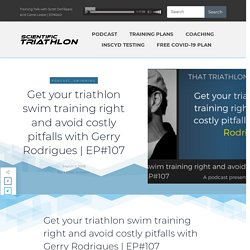
Let's discuss this episode and the topic in general. Post any comments or questions in the comments at the bottom of the shownotes. Join the discussion here! In this Episode you'll learn about: The 4 most common and most costly mistakes triathletes make in their swim training. Sponsored by: Precision HydrationOne size doesn't fit all when it comes to hydration. Triathlon CornerThe new online home of shopping the best triathlon products in the world to great prices. Shownotes About Gerry Rodrigues. Fitness and Technique in Triathlon Swimming with Rory Buck. Fitness and Technique in Triathlon Swimming with Rory Buck | EP#70 How do you structure your swim training as a triathlete to improve your fitness, technique, and performance?
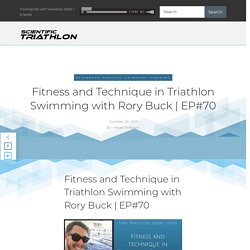
Swim Benches For Triathlon. After our blog on the humble turbo trainer, we received requests for my thoughts on swim benches and other swim tools used out of the water.
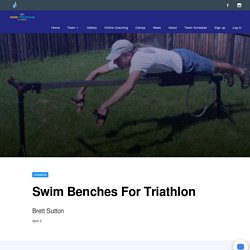
As we are now seeing most people around the world with no access to swimming pools, I thought I could pass on a little history with swim benches Let's first answer the burning question, do you believe they are beneficial? The answer is an unequivocal yes. However, it depends on what kind and if you use it to: Replace a swim workoutIncorporate it with your training session because you don't have a pool alternative. Then there are the many different swim benches available. Selecting Swim Interval Distances. One of the most frequent questions asked by athletes and coaches is why in swimming do we gravitate to shorter distance reps done many times?
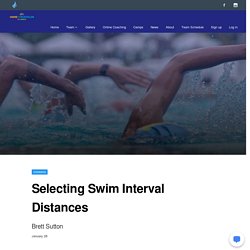
'If an Ironman race is 3.8km, why swim 40 x 100m instead of a straight 4km to 'get the distance'? ' The answer is about technique and the ability of the individual athlete to hold the stroke. In triathlon, even our shorter swims are considered 'long' by mainstream swimming standards. For an Olympic distance race we are swimming 1500m and for an Ironman 3800m, which for the sake of simplicity let's say equates to 1500 arm strokes for the shorter distance and 3800-4000 for the longer. This brings me to ask - what is more important? Using the rest intervals of the repetition can help us have both. How we break our own training down is often like this: 3 parts interval and 1 part rest. If this is held for over 45 minutes of actual work time, you will gain a cardiovascular benefit. Or we might change the intensity: A session such as 3 x (3 x 400m) 1.
Do you REALLY want to swim better? Do you REALLY want to swim better?
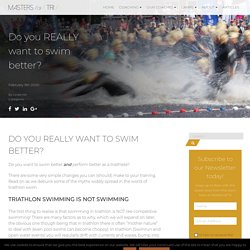
Do you want to swim better and perform better as a triathlete? There are some very simple changes you can (should) make to your training. The 7 Myths of Swimming for Triathlon. 1) The 6-Beat Kick A 6-beat technique is not a fundamental of swimming fast.
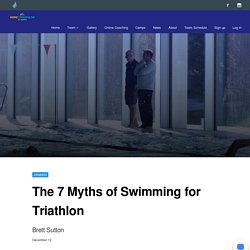
This is even truer in triathlon when we are covering 1500m, in ITU races or 3.8km, in Ironman. Triathlon coaches teaching the 6-beat kick to their charges may consider that even the best triathletes spend the next 7-hours minimum using their legs after the IM swim. So, to me it is unbelievable to think the 6-beat style is presented as the orthodox way to swim in triathlon. Especially when you realise that most can wear a wetsuit that gives every individual a lift of between 25-33% in body position. Swimmers do great quantities of kick work to develop the lift that triathletes are able buy straight off the rack. Don't Drink, Don't Sink. Each season brings a new group of triathletes and with them their inevitable water bottles to the side of the swimming pool.

Season after season I have tried to explain why this coach doesn't entertain them Before we start let me clarify; In very high heat and humidity camps we do allow water bottles on deck – in fact, encourage it. However, in normal circumstances our pros or age-groupers refrain from drinking out of a water bottle while swimming. Why? If we do an Ironman we are not able to replenish our hydration supplies for at least one hour in the swim. The actual time without hydration can be much more. Not only are you swimming without breaks, but there is plenty of time standing around after the warm-up being marshalled for the swim start. It has been my clear observation that there is no drink station on the swim course or at the start area before entering the water. To see athletes at swim training taking a drink between sets is bad enough. Developing the PUSH in the swim stroke. Developing the PUSH in the swim stroke As a triathlete, you want to swim, bike and run faster?!
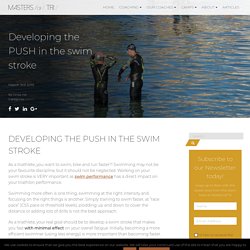
Swimming may not be your favourite discipline, but it should not be neglected. Our buoyancy debate input – part 1. Our buoyancy debate input – part 1 The buoyancy debate surrounding swim training is one of those never-ending topics; is it good, bad, or indifferent?
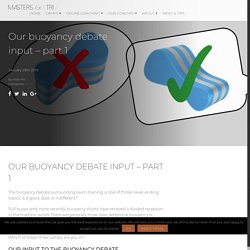
Pull buoys and, more recently, buoyancy shorts have received a divided reception in the triathlon world. There are generally three view; additional buoyancy is beneficial, some simply use it to make life easier / more enjoyable and others see it as a cheat that masks development. Our buoyancy debate input – Part 2. Swimming.